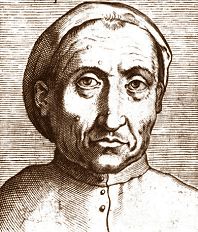Pietro Pomponazzi facts for kids
Quick facts for kids
Pietro Pomponazzi
|
|
|---|---|
 |
|
| Born | 16 September 1462 Mantua, Margravate of Mantua
|
| Died | 18 May 1525 |
| Alma mater | University of Padua |
| Scientific career | |
| Institutions | University of Padua |
| Academic advisors | Nicoletto Vernia |
| Notable students | Johannes Baptista Montanus Vittore Trincavelli |
Pietro Pomponazzi (born September 16, 1462 – died May 18, 1525) was an important Italian philosopher. A philosopher is someone who studies big ideas about life, knowledge, and what is real. Pietro was also known by his Latin name, Petrus Pomponatius.
Contents
Pietro Pomponazzi's Life Story
Pietro Pomponazzi was born in a city called Mantua in Italy. He started his education there. Later, he went to the University of Padua to continue his studies. In 1487, he became a medical doctor.
In 1488, Pietro was chosen to be a professor of philosophy at Padua. He taught there for many years. Around 1495, he became a professor of natural philosophy. This is a type of philosophy that studies nature and the physical world.
The schools in Padua closed in 1509. So, Pietro moved to Ferrara to teach. There, he lectured on the famous Greek philosopher Aristotle's book called De anima. This book is about the soul. In 1512, he moved to Bologna. He stayed there until he died. All of his most important writings were created in Bologna.
Ideas and Controversies
At Padua, medical science was very strong. But in Ferrara and Bologna, people were more interested in psychology (the study of the mind) and theological ideas (ideas about religion and God).
In 1516, Pietro wrote his most famous book. It was called De immortalitate animae, which means On the Immortality of the Soul. This book caused a lot of debate. Many groups argued about his ideas. These groups included the orthodox Thomists (followers of Thomas Aquinas) from the Catholic Church, the Averroists, and the Alexandrist School.
His book was even burned in Venice. Pietro himself was in danger because of his ideas. He wrote two more pamphlets, the Apologia and the Defensorium. In these, he tried to explain his views. He said he was a Catholic, but also a philosophical materialist. This meant he believed that everything is made of matter.
His last two books were published after he died. They were called De incantationibus and De fato.
A Thinker of the Renaissance
Pietro Pomponazzi was an important figure during the Renaissance. This was a time when people started to think in new ways. Old ways of thinking, called scholastic formalism, were losing their power.
During this time, attacking Aristotle's ideas was seen as very risky. But Pietro wanted to study Aristotle's writings for himself. He focused on Aristotle's De anima (On the Soul). He wanted to show that Thomas Aquinas had misunderstood Aristotle's ideas about the mind.
In his book On the Immortality of the Soul, Pietro argued that Aquinas and Aristotle had different ideas. He said that Aristotle believed the soul was mostly mortal. This means it would die with the body. Pietro was not the first to say this. He was influenced by Alexander of Aphrodisias, a Greek thinker who wrote about Aristotle.
Pietro also believed that humans could not prove the soul's immortality using only reason. He thought that believing in an immortal soul required God's power. He said that since religious texts show God made the soul immortal, we can accept this as true. This goes beyond what human reason can figure out.
Faith and Philosophy
Pietro Pomponazzi always said he believed in the Catholic faith. Even with the arguments about his book, the Church did not officially condemn it. This showed that for some thinkers, religion and philosophy could be different. They could even seem to disagree, but still exist for the same person.
Pietro showed this idea in his book De incantatione. In this work, he used Aristotle's ideas to argue against the existence of demons and spirits. But then, as a believing Christian, he said he had faith that they did exist. In this book, he also strongly emphasized that nature follows an orderly path of cause and effect. Things grow and then decay. He even suggested that religions, including Christianity, might also follow this pattern. He added that he was speaking as a philosopher when he said Christianity was showing signs of decline.
Pietro Pomponazzi died in Bologna.
See also
 In Spanish: Pietro Pomponazzi para niños
In Spanish: Pietro Pomponazzi para niños

